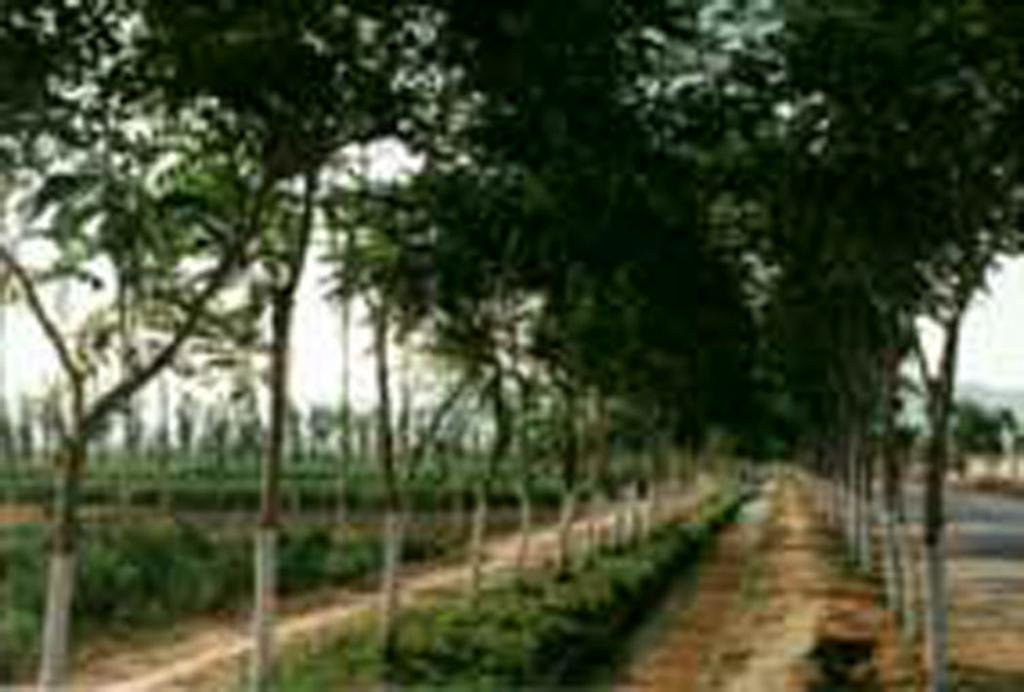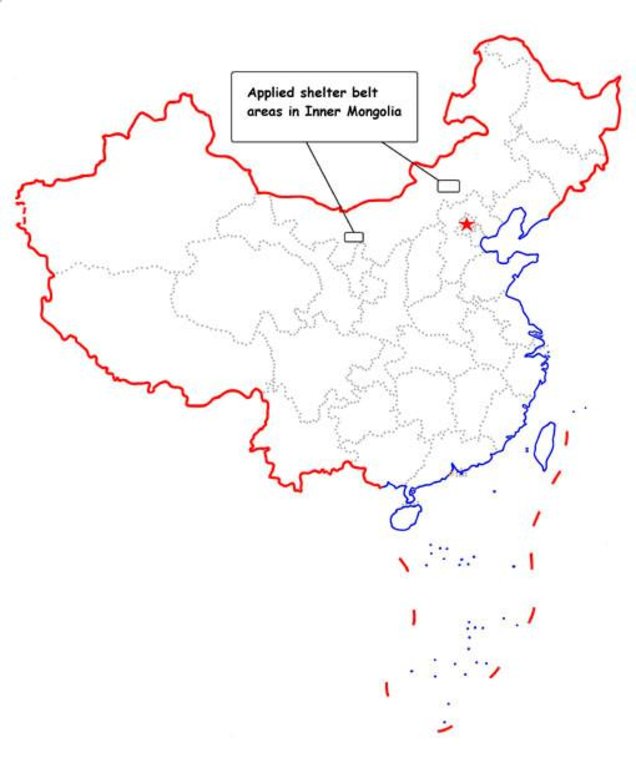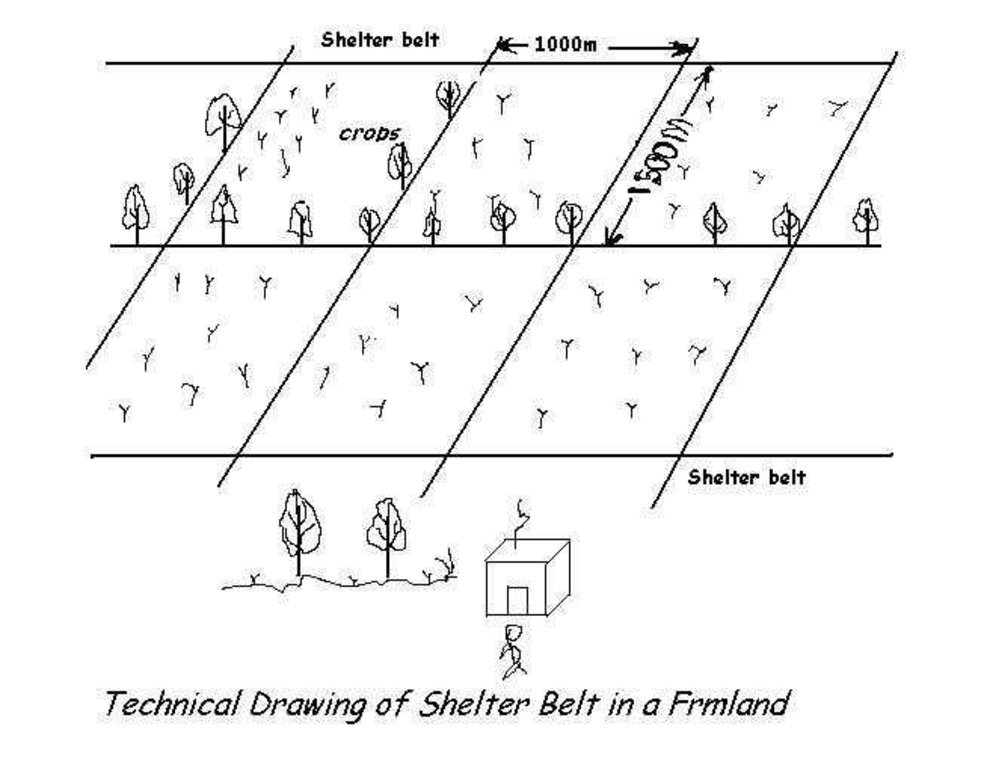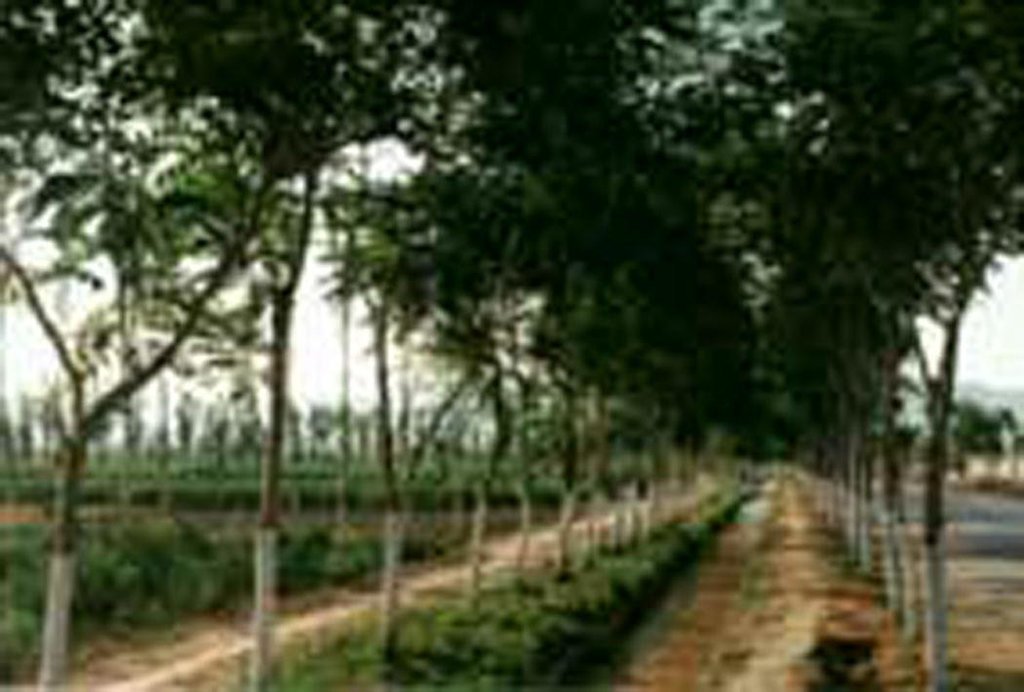Shelter Belt [China]
- Creation:
- Update:
- Compiler: Meili WEN
- Editor: –
- Reviewer: David Streiff
approaches_2396 - China
View sections
Expand all Collapse all1. General information
1.2 Contact details of resource persons and institutions involved in the assessment and documentation of the Approach
Name of the institution(s) which facilitated the documentation/ evaluation of the Approach (if relevant)
Department of Resources and Environmental Science, Beijing Normal University (Department of Resources and Environmental Science, Beijing Normal University) - China1.3 Conditions regarding the use of data documented through WOCAT
The compiler and key resource person(s) accept the conditions regarding the use of data documented through WOCAT:
Yes
1.4 Reference(s) to Questionnaire(s) on SLM Technologies
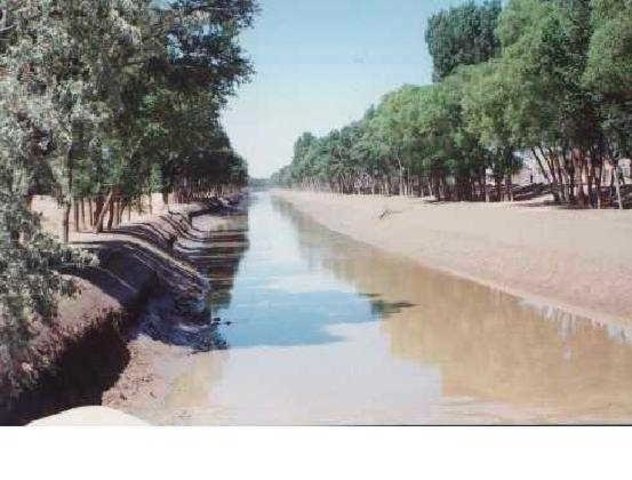
Shelterbelts for farmland in sandy areas [China]
Belts of trees, planted in a rectangular grid pattern or in strips within, and on the periphery of, farmland to act as windbreaks.
- Compiler: Meili WEN
2. Description of the SLM Approach
2.1 Short description of the Approach
The shelter belt is a strip or a row of trees planted in a farmland as a wind barrier to protect crops and reduce wind erosion.
2.2 Detailed description of the Approach
Detailed description of the Approach:
Aims / objectives: Overall purposes are improving environment, and then realization sustainable development of agriculture. Specific objectives are decreasing wind erosion of cropland, increasing foodstuff production. When this approach is decided to implement, the first things to be done are to investigate natural and social-economic environment. Then scope and stages of implementation are decided by government with provision of capital and policies. After that, the approach need to propagandize to people who live in the project area. To implement this approach step by step, local government and land users play an very important role in implementation of the approach.
2.3 Photos of the Approach
2.5 Country/ region/ locations where the Approach has been applied
Country:
China
Region/ State/ Province:
Inner Mongolia
Comments:
The data is from: Inner Mongolia forest department. Inner Mongolia autonomy region forest statistic data, 1987, p75.
Map
×2.6 Dates of initiation and termination of the Approach
Indicate year of initiation:
1960
Year of termination (if Approach is no longer applied):
1981
2.7 Type of Approach
- project/ programme based
2.8 Main aims/ objectives of the Approach
The Approach focused mainly on SLM with other activities (Modulation of air temperature, purifying air and increasing oxygen.)
The main objectives of the approach were reducing wind speed and keep soil moisture so as to be sustainable development of local land resources.
The SLM Approach addressed the following problems: Serious wind erosion in the farmland, and poor land management.
2.9 Conditions enabling or hindering implementation of the Technology/ Technologies applied under the Approach
availability/ access to financial resources and services
- hindering
No enough money
Treatment through the SLM Approach: Raising funds from different level of government
legal framework (land tenure, land and water use rights)
- hindering
Lack of enforcement of legislation
Treatment through the SLM Approach: Enforcement of legislation
The existing land ownership, land use rights / water rights moderately hindered the approach implementation Persuading land users to accept this SWC approach.
3. Participation and roles of stakeholders involved
3.1 Stakeholders involved in the Approach and their roles
- local land users/ local communities
Mongolian, Moslem, Korean minority nationalities, etc
Work equally divided between men and women
- SLM specialists/ agricultural advisers
A group of national and international specialists have been studying for a long time, and summarized this approach.
- national government (planners, decision-makers)
The implementing agencies are national government
3.2 Involvement of local land users/ local communities in the different phases of the Approach
| Involvement of local land users/ local communities | Specify who was involved and describe activities | |
|---|---|---|
| initiation/ motivation | self-mobilization | public meetings; They were involved in approach by public meeting and understood the approach. |
| planning | interactive | ublic meetings; They involved approach by public meeting and understand the approach |
| implementation | self-mobilization | casual labour; They increased their income by participating casual labour |
| monitoring/ evaluation | interactive | interviews/questionnaires; They pronounced their point of view by interviews or questionnaires |
| Research | interactive | They do not participate in. |
3.4 Decision-making on the selection of SLM Technology/ Technologies
Specify who decided on the selection of the Technology/ Technologies to be implemented:
- politicians/ leaders
Explain:
consultative.
Decisions on the method of implementing the SLM Technology were made by mainly by SLM specialists with consultation of land users. directive (top-down).
4. Technical support, capacity building, and knowledge management
4.1 Capacity building/ training
Was training provided to land users/ other stakeholders?
No
4.2 Advisory service
Do land users have access to an advisory service?
Yes
Specify whether advisory service is provided:
- on land users' fields
Describe/ comments:
On-the-job, farm visits, demonstration areas; Key elements: Quality of on-the-job, Effect of farm visits, Quality of demonstration areas; 1) Advisory service was carried out through: projects own extension structure and agents 2) Advisory service was carried out through: projects own extension structure and agents; Extension staff: mainly government employees 3) Target groups for extension: technicians/SWC specialists; Activities: Courses and demonstration
Advisory service is quite adequate to ensure the continuation of land conservation activities; All land users want to do this approach if they could get economic benefit from it. At each government level, there is a SWC division which is in charge of SWC activities including extension.
4.3 Institution strengthening (organizational development)
Have institutions been established or strengthened through the Approach?
- yes, moderately
Specify the level(s) at which institutions have been strengthened or established:
- local
Specify type of support:
- financial
4.4 Monitoring and evaluation
Is monitoring and evaluation part of the Approach?
Yes
Comments:
bio-physical aspects were regular monitored by 0 through measurements; indicators: None
technical aspects were regular monitored by 0 through measurements; indicators: None
socio-cultural aspects were ad hoc monitored by 0 through observations; indicators: None
economic / production aspects were ad hoc monitored by 0 through measurements; indicators: None
area treated aspects were regular monitored by 0 through measurements; indicators: None
no. of land users involved aspects were ad hoc monitored by 0 through measurements; indicators: None
management of Approach aspects were ad hoc monitored by 0 through observations; indicators: None
There were few changes in the Approach as a result of monitoring and evaluation: Improving the approach according to the practical effect.
4.5 Research
Was research part of the Approach?
Yes
Specify topics:
- economics / marketing
- ecology
Give further details and indicate who did the research:
This approach is applied for improving environment so as to relief their poverty.
Research was carried out on station
5. Financing and external material support
5.1 Annual budget for the SLM component of the Approach
If precise annual budget is not known, indicate range:
- 10,000-100,000
Comments (e.g. main sources of funding/ major donors):
Approach costs were met by the following donors: international (-): 25.0%; government (national): 55.0%; international non-government (-): 7.0%; national non-government (-): 3.0%; local community / land user(s) (-): 10.0%
5.2 Financial/ material support provided to land users
Did land users receive financial/ material support for implementing the Technology/ Technologies?
Yes
5.3 Subsidies for specific inputs (including labour)
- equipment
| Specify which inputs were subsidised | To which extent | Specify subsidies |
|---|---|---|
| machinery | fully financed | |
| tools | fully financed | |
- agricultural
| Specify which inputs were subsidised | To which extent | Specify subsidies |
|---|---|---|
| seeds | fully financed | |
| fertilizers | fully financed | |
| seedlings and biocides | fully financed | |
- infrastructure
| Specify which inputs were subsidised | To which extent | Specify subsidies |
|---|---|---|
| community infrastructure | fully financed | |
If labour by land users was a substantial input, was it:
- paid in cash
Comments:
Daily salary and materials as well as tools etc.
5.4 Credit
Was credit provided under the Approach for SLM activities?
Yes
Specify conditions (interest rate, payback, etc.):
Interest rate charged: 0.8%; repayment conditions: Varying every year, repayment is 5 years or 10 years..
Interest was lower than market rate.
6. Impact analysis and concluding statements
6.1 Impacts of the Approach
Did the Approach help land users to implement and maintain SLM Technologies?
- No
- Yes, little
- Yes, moderately
- Yes, greatly
This approach has little relationship to improve soil and water management.
Did the Approach improve issues of land tenure/ user rights that hindered implementation of SLM Technologies?
- No
- Yes, little
- Yes, moderately
- Yes, greatly
The policies of land contract distribute land to individuals so that land users who involved in SWC activities need to be organized together for implementation of the SWC. The organization need much time and hard work.
Did other land users / projects adopt the Approach?
- No
- Yes, little
- Yes, moderately
- Yes, greatly
A comprehensive SWC technology/approach has been formed based on the single measure such as shelter belt, terrace, check dams involved in agricultural development.
6.3 Sustainability of Approach activities
Can the land users sustain what has been implemented through the Approach (without external support)?
- uncertain
If no or uncertain, specify and comment:
If there are not support from outside, land users couldn't will implement SWC approach.
6.4 Strengths/ advantages of the Approach
| Strengths/ advantages/ opportunities in the land user’s view |
|---|
| Increasing their income (How to sustain/ enhance this strength: Increasing propagandizing and education about SWC knowledge.) |
| Strengths/ advantages/ opportunities in the compiler’s or other key resource person’s view |
|---|
| Improving agricultural production conditions. (How to sustain/ enhance this strength: Reinforcing management to this approach) |
| Increasing the land users' income (How to sustain/ enhance this strength: Changing part cropland to cash crops or fuit trees so as to get much return and maintain the sustainable SWC approach.) |
6.5 Weaknesses/ disadvantages of the Approach and ways of overcoming them
| Weaknesses/ disadvantages/ risks in the land user’s view | How can they be overcome? |
|---|---|
| Poor mamagement after the shelter belt construction. | Enhancing management of village communities forbidding deforest. |
| Weaknesses/ disadvantages/ risks in the compiler’s or other key resource person’s view | How can they be overcome? |
|---|---|
| Cost much money and more labour forces | The government should increase fund to implement this kind of approach. |
7. References and links
7.1 Methods/ sources of information
- compilation from reports and other existing documentation
7.2 References to available publications
Title, author, year, ISBN:
China atlas.China atlas publishing house, 1999, p25.
Available from where? Costs?
Library of the Department of Resource and Environmental Science, Beijing Normal University.
Title, author, year, ISBN:
Zhao Yu,Jing Zhengping, Shi Peijun, Hao Yunchong et al.Inner Mongolia soil erosion research remote sensing was used in Inner Mongolia soil erosion research,Science publishing house,1989, p25.
Available from where? Costs?
Library of the Department of Resource and Environmental Science, Beijing Normal University.
Title, author, year, ISBN:
Inner Mongolia forest department, Forest work manual,1998,12, p33-34, p67
Available from where? Costs?
Library of the Department of Resource and Environmental Science, Beijing Normal University.
Title, author, year, ISBN:
Synthesized investigate team in Inner Mongolia-Ningxia, CAS.West of northeast Forest in Inner Mongolia autonomy region, Science publishing house,1981, p82-101.
Available from where? Costs?
Library of the Department of Resource and Environmental Science, Beijing Normal University.
Title, author, year, ISBN:
Sun Jinzhu. Natural condition and reconstruct in Hetao plain,Inner Mongolia people's publishing house,1976, p188-189.
Available from where? Costs?
Library of the Department of Resource and Environmental Science, Beijing Normal University.
Title, author, year, ISBN:
Inner Mongolia forest Department. Inner Mongolia autonomy region forest statistic data,1987, p75.
Available from where? Costs?
Library of the Department of Resource and Environmental Science, Beijing Normal University.
Title, author, year, ISBN:
Hu Chun(chief editor). Inner Mongolia autonomy region climate resources about agriculture, forest and animal husbandry, Inner Mongolia people's publishing house, 1984, p45-47.
Available from where? Costs?
Library of the Department of Resource and Environmental Science, Beijing Normal University.
Title, author, year, ISBN:
Water and soil conservation bureau, Yellow River irrigation works committee of Department of water and electricity. Water and soil conservation economy benefit thesis collecting,1987, p45-47.
Available from where? Costs?
Library of the Department of Resource and Environmental Science, Beijing Normal University.
Title, author, year, ISBN:
Sun Jinzhu,Chen Shan(chief editor). Inner Mongolia environmental alarm beforehand and repair countermeasure. Inner Mongolia people's publishing house,1994, p132.
Available from where? Costs?
Library of the Department of Resource and Environmental Science, Beijing Normal University.
Links and modules
Expand all Collapse allLinks

Shelterbelts for farmland in sandy areas [China]
Belts of trees, planted in a rectangular grid pattern or in strips within, and on the periphery of, farmland to act as windbreaks.
- Compiler: Meili WEN
Modules
No modules



